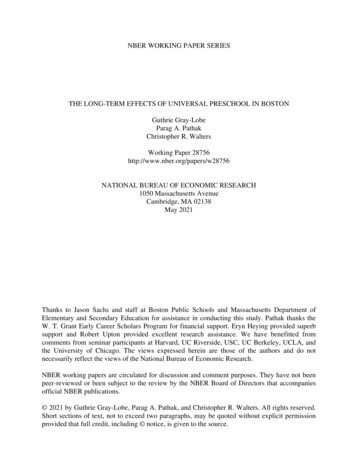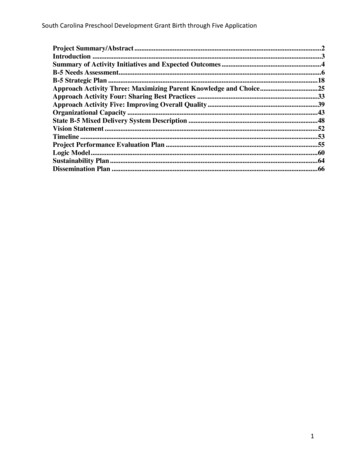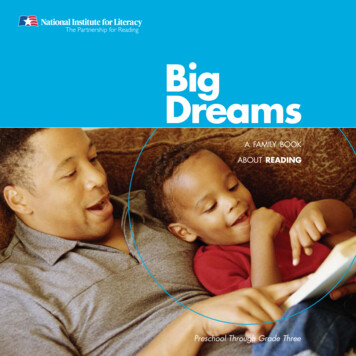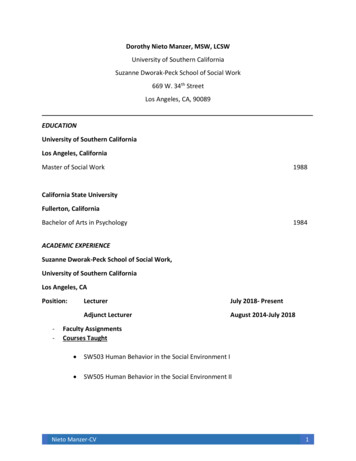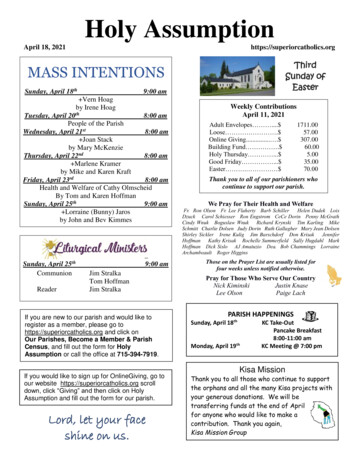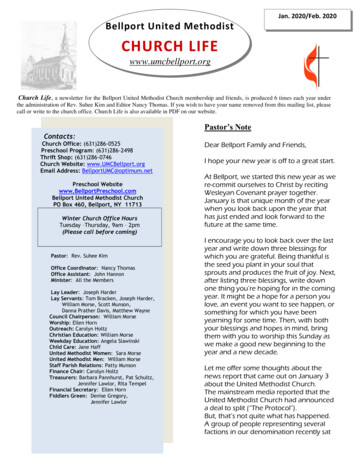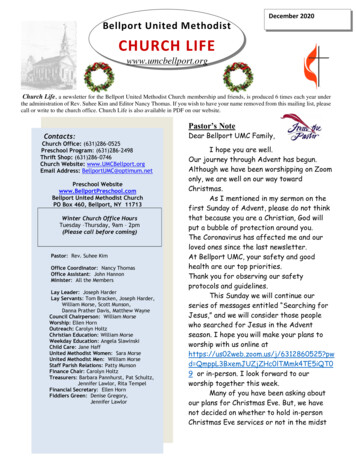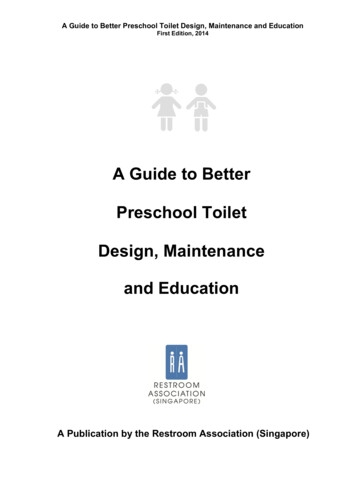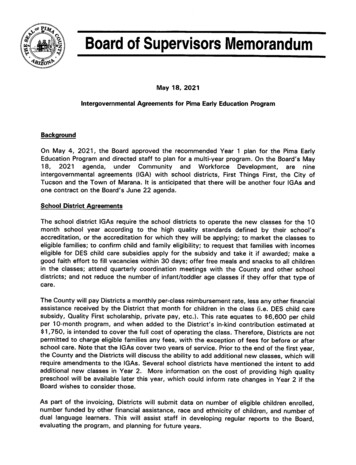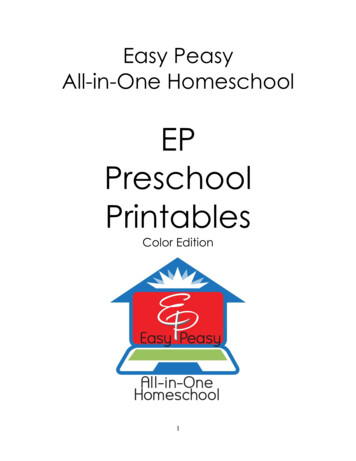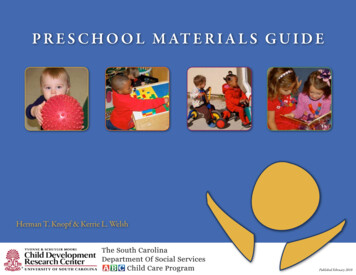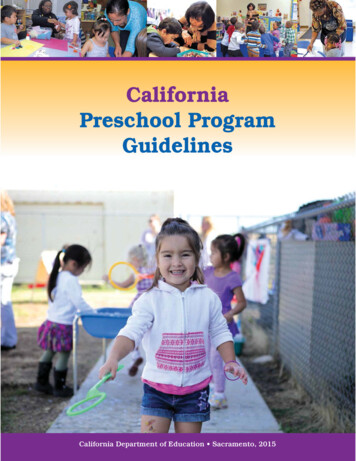
Transcription
CaliforniaPreschool ProgramGuidelinesCalifornia Department of Education Sacramento, 2015
CaliforniaPreschool ProgramGuidelines
Publishing InformationCalifornia Preschool Program Guidelines was prepared under the direction ofthe Early Education and Support Division, California Department of Education. This publication was edited by Faye Ong and John McLean, workingin cooperation with Laura Bridges, Child Development Consultant. It wasdesigned and prepared for printing by the staff of CDE Press, with the cover andinterior design created and prepared by Karen Phillips. It was published by theDepartment of Education, 1430 N Street, Sacramento, California 95814. It wasdistributed under the provisions of the Library Distribution Act and GovernmentCode Section 11096. 2015 by the California Department of EducationAll rights reservedISBN 978-0-8011-1750- Reproduction of this document for resale, in whole or in part, is not authorized.Ordering InformationCopies of this publication are available for purchase from the California Department of Education. For prices and ordering information, please visit the Department Web site at http://www.cde.ca.gov/re/pn/rc/ or call the CDE Press salesRIÀFH DW NoticeThe guidance in California Preschool Program Guidelines is not binding onlocal educational agencies or other entities. Except for the statutes, regulations,and court decisions that are referenced herein, the document is exemplary, andcompliance with it is not mandatory. (See Education Code Section 33308.5.)
ContentsA Message from the State Superintendent of Public Instruction .viiAcknowledgments .viiiIntroduction . xii1Part OneSetting the Stage for Program QualityChapter 1Current Issues in Early Childhood Education . 3General Issues. 3Evidence from Research . 3The Need for High-Quality Preschool Programs . 5Early Childhood Investments and Societal Impacts. 5Recent Research on Brain Development . 6School Readiness . 10The California Context. 11Readiness Gap . 12Desired Results for Children and Families . 12Overview of Preschool Learning Foundations . 15Closing Thoughts . 15References . 16Chapter 2The Preschool Child. 19The Five Essential Domains of School Readiness . 22Social–Emotional Development . 24Language and Literacy . 24Cognition and General Knowledge . 26Physical Well-Being and Motor Development . 29Approaches Toward Learning . 31The Role of Play in Children’s Learning and Development . 32Closing Thoughts . 33References . 34Further Reading . 35Chapter 3The Role of the Preschool Teacher . 39Build and Maintain Positive Relationships with Children . 39Build and Maintain Positive Relationships with Families . 40Create an Environment for Social and Emotional Learning . 41Be Responsive to Children’s Linguistic and Cultural Experiences . 42iii
Include Children with a Wide Range of Abilities and Approachesto Learning . 42Understand Children’s Needs and Capabilities . 43Plan the Learning Environment and Curriculum in the Domains ofSchool Readiness . 44Balance Child-Initiated and Teacher-Initiated Activities. 45Assess How Well the Program Meets Children’s Needs . 46Closing Thoughts . 48References . 48Further Reading . 48Chapter 4The Role of the Administrator . 51Reflective Curriculum Planning . 53Setting the Conditions for Work . 56Creating a Collaborative Work Environment and Learning Community . 58Integrating Reflective Practice, Reflective Supervision, and Mentorship .59Accountability to Maintain Program Quality . 61Closing Thoughts . 62References . 63Further Reading . 6465Part TwoSupporting Young Children’s Learning and DevelopmentChapter 5Use of the California Preschool Curriculum Framework . 67Integrated Curriculum for Young Dual Language Learners. 69Universal Design . 70The Curriculum Planning Process . 70Closing Thoughts . 73References . 74Further Reading . 74Chapter 6Support for Young Dual Language Learners. 75Guiding Principles for Supporting Young Dual Language Learners . 76Characteristics of Preschool Dual Language Learners . 76Program Approaches and Teaching Practices . 80Assessment of Young Dual Language Learners . 87Family Engagement. 87Inclusion of Young Dual Language Learners Who Have Special Needs . 88Support for the Transition to Kindergarten . 89Early Childhood Educator Competencies. 89Closing Thoughts . 90References . 91Further Reading . 91iv
Chapter 7Using Technology and Interactive Media with Preschool-Age Children .93Children and Electronic Media . 93Technology and Interactive Media in the Preschool Environment . 94The Benefits and the Challenges of Using Technology and Interactive Media . 95Selecting Technology and Interactive Media to Enhance Children’s Learning . 97Integrating and Using Technology in the Preschool Environment . 99Training and Professional Development Opportunities . 101References . 101Further Reading . 103Part Three Program GuidelinesChapter 8105Guidelines for Operating Preschool Programs. 107Guideline 1:Aspiring to Be a High-Quality Program . 107Guideline 2:Addressing Culture, Diversity, and Equity . 115Guideline 3:Supporting Relationships, Interactions, and Guidance . 122Guideline 4:Engaging Families and Communities . 130Guideline 5:Including Children with Disabilities or Other Special Needs . 141Guideline 6:Promoting Health, Safety, and Nutrition . 155Guideline 7:Assessing Children’s Development and Learning . 161Guideline 8:Planning the Learning Environment and Curriculum . 169Guideline 9:Supporting Professionalism and Continuous Learning . 185Guideline 10: Administering Programs and Supervising Staff . 196Appendixes207Appendix A:Resources for Early Care and Education Programs . 209Appendix B:Books and Media on Early Education by theCalifornia Department of Education . 217Appendix C:California Preschool Children Enrolled in Special Education . 220Appendix D: Desired Results for Children and Families . 221Appendix E:State and Federal Laws Regarding People with Disabilities . 224Appendix F:Summary of the California Preschool Program Guidelines . 227Appendix G: Resources on Early Childhood Inclusive Practice . 228Appendix H: Member of the Class: Teachers Guide . 234GlossaryAppendix I:Effective Strategies for Observing Children’s Learningand Behavior . 235Appendix J:Child Development Permit Matrix . 237Appendix K:NAEYC Code of Ethical Conduct and Statementof Commitment . 238247v
A Message from the StateSuperintendent of Public InstructionIam pleased to present the California Preschool Program Guidelines, a critical publi cation providing administrators, teachers, and college instructors with guidance onthe essential elements of high-quality preschool programs. A better preschool pro gram will ensure success in our efforts to close the school-readiness gap. This publica tion complements and builds upon policies adopted by the State Board of Educationand recent publications by the California Department of Education, Early Educationand Support Division. The guidelines in this publication present a broad picture ofhigh-quality preschool programming, based on the most recent research available, thatoptimize our ability to meet the needs of children in California’s diverse preschool set tings and communities.The Preschool Program Guidelines draw both upon current research and the collec tive professional wisdom of California’s numerous early childhood educators who havecontributed to the creation of the California Early Learning and Development System.This publication features three main sections: Part One: Setting the Stage for ProgramQuality; Part Two: Supporting Young Children’s Learning and Development; and PartThree: Program Guidelines. This publication is best used in conjunction with otherCalifornia Department of Education publications in the California Early Learning andDevelopment System. Of particular note is a chapter on research-based program ap proaches and practices that best support the learning and development of young duallanguage learners. Considerations for inclusion of children with disabilities or otherspecial needs are integrated throughout the publication, and a chapter on using tech nology and interactive media in preschool settings is included. To highlight key pointsfrom the California Preschool Program Guidelines, a companion DVD set is available todeepen professional knowledge and understanding.The guidelines and examples in this publication offer to preschool professionals acomprehensive view of policies and practices that establish a solid foundation on whichto build high-quality preschool programs for California’s future. The California Pre school Program Guidelines speaks to new early childhood administrators and teachersas well as experienced ones. The publication recognizes the best practices already inplace in many preschool programs while providing new insights and strategies to opti mize the enduring positive impacts of high-quality preschool learning experiences thathelp ensure the well-being and successful development of our state’s young children.TOM TORLAKSONState Superintendent of Public Instructionvii
AcknowledgmentsThe development of the California Preschool Program Guidelines involved manypeople. The following groups contributed: project leaders; principal writers; ad visers on English-language development; universal design advisers; consultantsand reviewers; project staff and advisers from the WestEd Center for Child and FamilyStudies; staff from the California Department of Education; and early childhood educa tion stakeholder organizations.Project LeadersThe following staff members are gratefullyacknowledged for their contributions:Elita Amini Virmani, Peter L. Mangione,and Katie Monahan, WestEd.Principal WritersSpecial thanks are extended to theprincipal writers for their expertise andcontributions:IntroductionElita Amini Virmani, WestEdPeter L. Mangione, WestEdChapter 1: Current Issues in EarlyChildhood EducationElita Amini Virmani, WestEdPeter L. Mangione, WestEdChapter 2: The Preschool ChildElita Amini Virmani, WestEdPeter L. Mangione, WestEdChapter 3: The Role of the PreschoolTeacherElita Amini Virmani, WestEdPeter L. Mangione, WestEdChapter 4: The Role of the AdministratorJanet Thompson, University of California,DavisChapter 5: Use of the CaliforniaPreschool Curriculum FrameworkPeter L. Mangione, WestEdChapter 6: Support for Young DualLanguage LearnersLinda Espinosa, Center for Early Careand Education Research—DualLanguage Learners, Frank PorterviiiGraham Child Development Institute,University of North Carolina, ChapelHillChapter 7: Using Technology andInteractive Media with Preschool-AgeChildrenOsnat Zur, WestEdChapter 8: Guidelines for OperatingPreschool ProgramsElita Amini Virmani, WestEdLinda Brault, WestEdLaura Bridges, Early Education andSupport Division, CDELinda Espinosa, Co-PrincipalInvestigator, Center for Early Care andEducation Research—Dual LanguageLearners, Frank Porter Graham ChildDevelopment Institute, University ofNorth Carolina, Chapel HillCecelia Fisher-Dahms, Early Educationand Support Division, CDEPeter L. Mangione, WestEdDesiree Soto, Early Education andSupport Division, CDEAdviser on English-LanguageDevelopmentParticular thanks are extended to thefollowing adviser in appreciation of herextensive involvement in the project:Linda Espinosa, Co-PrincipalInvestigator, Center for Early Care andEducation Research—Dual LanguageLearners, Frank Porter Graham ChildDevelopment Institute, University ofNorth Carolina, Chapel Hill
Universal Design AdviserCalifornia Department of Education*The following universal design expertis gratefully acknowledged for hercontributions:Linda Brault, WestEdThanks are extended to the following staffmembers: Richard Zeiger, Chief DeputySuperintendent; Lupita Cortez Alcalá,Deputy Superintendent of Instructionand Learning Support Branch; DebraMcMannis, Director, Early Education andSupport Division; Cecelia Fisher-Dahms,Administrator, Quality Improvement Of fice; Desiree Soto, Administrator, North ern Field Services; Laura Bridges, ChildDevelopment Consultant, for ongoingrevisions and recommendations. Dur ing the development process, many CDEstaff members were involved at variouslevels. Additional thanks are extendedto Deborah Sigman, Deputy Superinten dent, District, School, and InnovationSupport Branch; Gavin Payne, formerChief Deputy Superintendent, and thefollowing Early Education and SupportDivision staff members: Gail Brodie, SyDang Nguyen, and Charles Vail and thefollowing Special Education Division staffmember: Meredith Cathcart.Additional Consultants and ReviewersParticular thanks are extended to thefollowing consultants in appreciation oftheir involvement in the project:Advisory Group: California’s Best Practic es for Young Dual Language LearnersLinda Espinosa, Co-PrincipalInvestigator, Center for Early Care andEducation Research—Dual LanguageLearners, Frank Porter Graham ChildDevelopment Institute, University ofNorth Carolina, Chapel HillOscar Barbarin, Tulane UniversityLuz Marina Cardona, Cabrillo CommunityCollegeDeborah Chen, California StateUniversity, NorthridgeBarbara Conboy, University of RedlandsClaude Goldenberg, Stanford UniversityVera Gutiérrez-Clellen, San Diego StateUniversityLinda Halgunseth, University ofConnecticutGisela Jia, Lehman CollegeKaren Nemeth, Language Castle LLCCatherine Sandhofer, University ofCalifornia, Los AngelesYuuko Uchikoshi, University ofCalifornia, DavisMarlene Zepeda, California StateUniversity, Los AngelesWestEd Center for Child and FamilyStudies—Project Staff and Advisers:Linda BraultMelinda BrookshireJenae LeahyGina MorimotoCaroline Pietrangelo OwensTeresa RagsdaleAmy Schustz-AlvarezLaurel SteverAnn-Marie WieseEarly Childhood Education StakeholderOrganizationsRepresentatives from many statewideorganizations provided perspectivesaffecting various aspects of the programguidelines.Action Alliance for ChildrenAlliance for a Better CommunityAsian Pacific Islander Community ActionNetwork (APIsCAN)Association of California SchoolAdministratorsBaccalaureate Pathways in EarlyChildhood & Education (BPECE)Black Child Development Institute (BCDI),Sacramento AffiliateCalifornia Alliance of African AmericanEducators (CAAAE)California Association for BilingualEducation (CABE)California Association for the Educationof Young Children (CAEYC)*The names and affiliations of all individuals werecurrent at the time of the development of this pub lication.ix
California Association for Family ChildCare (CAFCC)Council of CSU Campus Child Care(CCSUCC)California Association of LatinoSuperintendents and Administrators(CALSA)California Child Care CoordinatorsAssociation (CCCCA)Curriculum Alignment Project (CAP)Curriculum and Instruction SteeringCommittee (CISC)California Child Care Resource andReferral Network (CCCRRN)California Child DevelopmentAdministrators Association (CCDAA)California Child Development CorpsCalifornia Commission on TeacherCredentialing (CCTC)California Community College EarlyChildhood Educators (CCCECE)California Community CollegesChancellor’s Office (CCCCO)California County SuperintendentsEducational Services Association(CCSESA)California Early Childhood MentorProgramCalifornia Early Reading First NetworkCalifornia Federation of Teachers (CFT)California Head Start Association (CHSA)California Kindergarten Association (CKA)California Preschool InstructionalNetwork (CPIN)California School Boards AssociationCalifornia State PTACalifornia State University Office of theChancellorCalifornia Teachers AssociationCalifornians TogetherCampaign for Quality Early Education(CQEE)Center for the Study of Child CareEmployment (CSCCE) at UC BerkeleyChild Development Policy Institute (CDPI)Child Development Training Consortium(CDTC)Children NowThe Children’s CollabriumCoalition of Family Literacy in CaliforniaCouncil for Exceptional Children/California Division for Early Childhood(Cal-DEC)xDavid and Lucile Packard Foundation—Children, Families, and CommunitiesProgramDesired Results access ProjectEarly Edge CaliforniaEarly Learning Advisory CouncilFaculty Initiative ProjectFederal/State/Tribes CollaborationWorkgroupFight Crime: Invest in Kids CaliforniaFirst 5 Association of CaliforniaFirst 5 California (California Children &Families Commission)Head Start State-Based Training andTechnical Assistance Office forCaliforniaInfant Development Association ofCalifornia (IDA)Learning Disabilities Association ofCaliforniaLos Angeles Universal Preschool (LAUP)Mexican American Legal Defense andEducational Fund (MALDEF)Migrant Education Even Start (MEES)Migrant Head StartNational Council of La Raza (NCLR)Professional Association for ChildhoodEducation (PACE)Special Education Administrators ofCounty Offices (SEACO) CommitteeSpecial Education Local Plan AreaAdministrators of California (SELPA)TeenNOW CaliforniaThe Tribal Child Care Association ofCaliforniaUniversity of California, Child CareDirectorsUniversity of California, Office of thePresident (UCOP)Voices for African American Students, Inc.(VAAS)Zero to Three
PhotographsMany photographers contributed to alarge pool of photographs taken overthe years and collected by WestEd.Special thanks are extended to WestEdand the photographers. The followingchild care agencies deserve thanks forallowing photographs to be taken of staffmembers, children, and families:Child Development Center, AmericanRiver College, Los Rios CommunityCollege District, SacramentoFriends of Saint Francis Childcare Center,San FranciscoLincoln Street State Preschool, TehamaCounty Department of Education, RedBluffThermalito Learning Center Preschool,OrovilleWest Grand Head Start, OaklandEl Jardín de los Niños at UniversityPreparation School at California StateUniversity Channel Islands, Camarilloxi
IntroductionCalifornia Preschool Program Guide lines provides the detailed guidanceneeded by administrators1 andteachers to offer high-quality preschoolprograms that prepare children to arrivein kindergarten with the foundationalskills necessary for school success. Thepurpose of this publication is to presentan overview of key issues to be consideredin planning and implementing a highquality preschool program.The primary audience for this publica tion is early childhood education (ECE)professionals who are responsible forpreschool program planning. When thedocument is used in combination withother resources (detailed below) offered bythe California Department of Education(CDE), it can also be helpful and informa tive to a broader audience of policymak ers, school administrators, teaching staff,parents, and others who are committed tohigh-quality preschool education for all ofCalifornia’s children.Need for the GuidanceThis publication responds to the need fora common understanding about what con stitutes high-quality programming acrossa broad spectrum of curriculum andpractice for preschools. It also takes intoaccount what high-quality preschool pro gramming means in the context of Cali fornia’s move toward higher expectationsfor all students at the elementary andsecondary school levels. It complementsand builds upon policies adopted by theState Board of Education and documentspublished by the CDE.The guidelines in Part Three present abroad picture of high-quality program ming that should be used to meet theneeds of children in California’s diversepreschool settings and communities. Al though the guidelines are not mandatory,1. Terms in boldface are defined in the glossary.xiithey represent the best practices based oncurrent scientific evidence in early child hood education and are strongly recom mended by the CDE for all preschoolprograms.This publication recognizes that one ofthe great attractions for professionals inearly childhood education is the potentialto make a significant and lasting impacton the lives of young children and theirfamilies. Rather than attempt to prescribeexactly what should be happening in aprogram at any given time or specificallywhat should be taught and what methodsshould be used, it proposes principles andrelated practices for developing preschoolprograms that support the diverse learn ing needs of young children in California.Organization of the ContentThis publication is divided into threemain parts: Part One—Setting the Stage for Pro gram Quality Part Two—Supporting Young Chil dren’s Learning and Development Part Three—Program GuidelinesPart One, Setting the Stage for Pro gram Quality, consists of chapters 1–4.Chapter 1 presents key backgroundinformation and the many resourcesavailable to preschool administrators andearly childhood educators in California,highlighting resources developed by theCDE that are cited in this publication.It presents the background and contextof early childhood education, especiallyrecent developments in the field in Cali fornia. Chapter 2 focuses on the majoradvances that occur during the preschoolyears in the areas of physical, cognitive,language, and social–emotional develop ment. The chapter uses the five essentialdomains of school readiness and the Cali fornia Preschool Learning Foundations toorganize what is known about children’s
learning and development. Chapter 3 dis cusses the role of the preschool teacherin supporting children’s high-quality earlylearning experiences. Chapter 4 focuseson the role of the preschool program ad ministrator in designing and implement ing a high-quality preschool program.Part Two, Supporting Young Chil dren’s Learning and Development,consists of three chapters about bestpractices in preschool settings. Chap ter 5 provides readers with an overviewof the California Preschool CurriculumFramework, highlighting aspects of cur riculum planning that are most relevantfor program directors or administrators.Chapter 6 addresses program practicesand approaches that support the learningand development of young dual languagelearners. Chapter 7 has suggestions onhow to integrate the use of technologyinto preschool programs to support chil dren’s learning and development.Part Three, Program Guidelines,consists of a single chapter (8) coveringguidelines for operating preschool pro grams. Considerations regarding practicesthat best support young dual languagelearners,2 as well as children with disabili ties or other special needs, are attendedto throughout the following 10 guidelines:(1) Aspiring to Be a High-QualityProgram(2) Addressing Culture, Diversity, andEquity(3) Supporting Relationships,Interactions, and Guidance(4) Engaging Families and Communities(5) Including Children with Disabilitiesor Other Special Needs(6) Promoting Health, Safety, andNutrition(7) Assessing Children’s Developmentand Learning(8) Planning the Learning Environmentand Curriculum2. Dual language learners are young children learningtwo or more languages at the same time, as well asthose learning a second language while continuing todevelop their first (or home) language.(9) Supporting Professionalism andContinuous Learning(10) Administering Programs andSupervising StaffAppendixes A through K offer a varietyof resources for program implementationand improvement.The guidelines and examples in thispublication offer clear directions on thebest practices for preschool professionals.This material draws on current researchand on the collective professional experi ence of California’s numerous early child hood educators who have contributedto the creation of the California EarlyLearning and Development System. Theguidelines represent a solid foundationon which to build high-quality preschoolprograms for California’s future.Related PublicationsThis publication is a resource to beused in conjunction with other publica tions developed by the CDE to supportearly childhood education professionals.Over the past 10 years, the CDE’s EarlyEducation and Support Division (formerlycalled the Child Development Division)developed the California Early Learningand Development System. The systemprovides early childhood education pro fessionals with an integrated set of pro grams, publications, and initiatives basedon state-of-the art science of early learn ing and development and best practicesin education: “Each component area inthe system provides resources that focuson a different aspect of supporting pre school teachers and links to the resourcesprovided in every other component of thesystem” (CDE 2010b, 30). The followingsection provides an overview of the com ponents of the California Early Learningand Development System, highlightingthose resources in the system that sup port preschool p
Universal Design Adviser The following universal design expert is gratefully acknowledged for her contributions: Linda Brault, WestEd Additional Consultants and Reviewers Particular thanks are extended to the following consultants in appreciation of their involvement i
